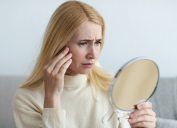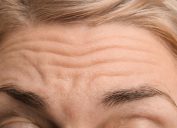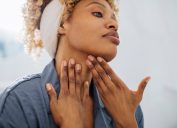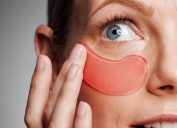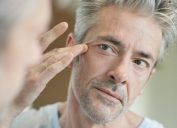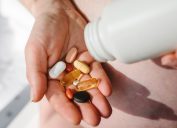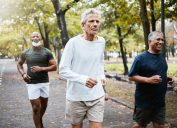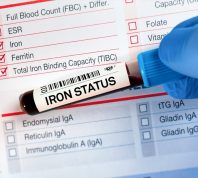What Is "Runner's Face" and How Do You Avoid It?
Plastic surgeons have known about this for years.
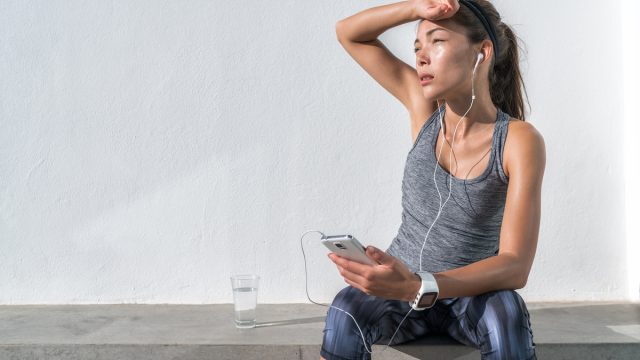
Running is one of the best types of exercise: Studies say it can improve your cardiovascular health, boost your mood, and even reduce the risk of arthritis and memory issues. But if you've spent time online recently, you may have heard it can also cause characteristic skin changes, often described as "runner's face." What exactly does that mean, you ask? Keep reading to learn what plastic surgeons have to say about it.
RELATED: What Is "Ozempic Face" and How Do You Treat It?
What Is Runner's Face?
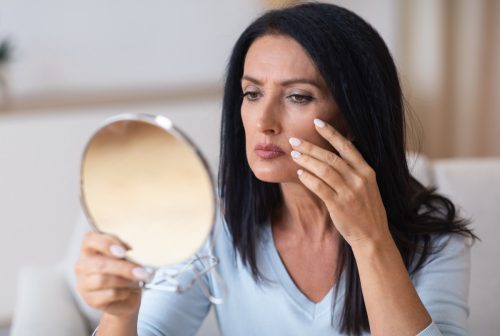
There's no official definition for runner's face, but medical professionals recognize the phenomenon.
"In general, it refers to the skeletal appearance that runners often get in the face area," says Dennis Schimpf, MD, a plastic surgeon based in Charleston. "There's no indication or research that running actually causes aging to happen faster—but it clearly does change the way a person appears."
In addition to sometimes causing an overall gaunt appearance, this kind of exercise can also impact the skin.
"The term generally describes the appearance of discolored, wrinkled skin of the face which can look leathery, tired, or older than the individual's true age," says Samuel J. Lin, MD, FACS, an associate professor of surgery at Harvard Medical School and plastic surgeon in Boston.
When Did the Term Take Off?
Most people first heard the term on TikTok. In Feb. 2023, Gerald Imber, MD, a plastic surgeon and anti-aging expert, posted a video about the concept, saying certain exercises can accelerate weight loss and wrinkles—and running long distances just so happens to be one of them.
"Have you ever seen a long-distance long-time runner that didn't have a great old face," he asks. "That's what happens: In addition to the gaunt old face, your knees go, your back goes, and it's kind of dumb."
He adds that it's "perfectly fine" to run a little bit every day or a few miles a few times a week.
RELATED: How to Get Rid of Forehead Wrinkles: 18 Dermatologist-Approved Tips.
What Causes Runner's Face?
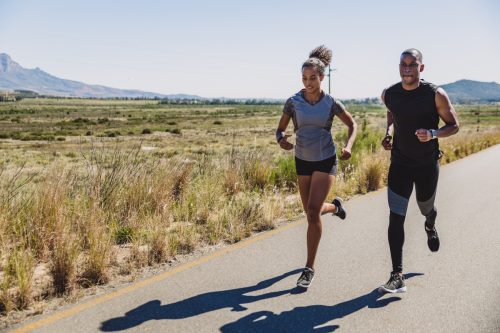
Developing runner's face is likely associated with a few different things. Here's what plastic surgeons say contributes the most.
Low Body Fat
Studies show that distance runners tend to have lower body fat than inactive people, especially those ages 35 and older. That's good for some things and less so for others.
"Subcutaneous fat provides volume and support to the skin, smoothing out fine lines and wrinkles and providing a fuller, refreshing, and younger look," says Elie Levine, MD, a board-certified plastic surgeon in New York City. "As we age, this volume naturally decreases, so if you have low body fat to start, your volume is already diminished, and your skin will appear aged."
Unsupported Skin
Low body fat in the face can also lead to unsupported skin. Think, for example, about the facial fat on the cheeks and the fat pads surrounding the eyes. If those disappear, then the skin loses support, explains Leo Lapuerta, MD, a plastic surgeon in Houston. That can cause a sagging effect.
You might also look somewhat sallow. "The loss of fat pads around the eye area leaves the eyes looking tired and hollowed out, and the look of tired eyes only augments the gaunt look of the face," says Lapuerta.
Sun Damage
Many runners spend hours outside, which can evolve into chronic sun exposure.
"The sun's effect on the skin is known as photoaging and has been demonstrated to cause increased wrinkles, poor skin texture, and discoloration," says Lin. "Because runners tend to spend more time exposed to the sun and potentially without sun protection, the UV damage from the sun can cause signs of photoaging over time, which collectively can lead to what is called runner's face."
Lin adds that research has also found that sweating can intensify the damage ultraviolet light exposure has on the skin.
Free Radicals
It's not just the sun that takes a toll on the skin when running. "Your skin is also exposed to free radicals and other environmental elements, thereby becoming vulnerable to oxidative damage, which can cause the skin to look more gaunt, saggy, wrinkly, and dull," says Levine.
RELATED: 5 Best Anti-Aging Supplements, According to a Doctor.
How Can You Prevent Runner's Face?
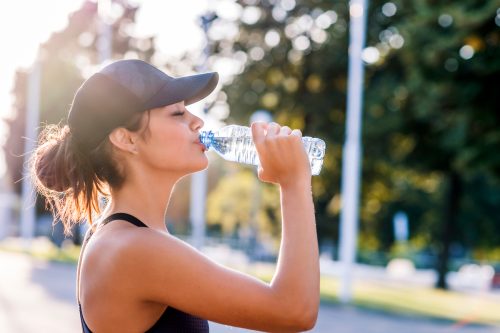
Avoid Running in the Sun
This way, you decrease your exposure as much as possible. "Runners should be advised to minimize midday running and run in the shade when possible," says Lin. You can also wear a hat, protective clothing, and sunglasses to lower your risk.
…And Wear Sunscreen If You Do
Wearing sunscreen is a major defense against premature aging.
"It should be applied to dry skin before heading outdoors, even on cloudy days, and allowed to dry," says Lapuerta. "It should be reapplied frequently while outdoors, and care should be taken to remember to apply to the ears and neck."
Use SPF 15 or higher on the face, body, and lips for the best protection against harmful UV rays, suggests Lapuerta.
Wash Your Face After Your Run
The American Academy of Dermatology Association (AAD) suggests using warm water after exercise to remove sweat, dirt, and oil.
Stay Hydrated
You need adequate hydration to power your runs, and doing that will also help protect against runner's face.
"Poor hydration may cause the skin to look drier and less firm," says Lin. "Adequate water intake helps maintain skin health. If runners do not adequately hydrate, the overall effect can contribute to the appearance of 'runner's face.'"
Bring along a water pack, or hit the water fountain as you go, especially is you practice long-distance running.
Keep Your Skin Moisturized
You also want to hydrate your skin from the outside. "Using nutrient-rich moisturizers and skincare products containing antioxidants can help combat oxidative stress and maintain skin hydration and elasticity," says Alexis Pfropper, a licensed esthetician and founder of ästhetik skincare.
Don't Smoke
Smoking can increase the effects of aging and amplify the effects of runners' face. According to the American Osteopathic College of Dermatology (AOCD), you may notice dry skin, uneven skin tone, baggy eyes, a saggy jawline, and deeper wrinkles and furrows.
"It is common for the skin of a 40-year-old heavy smoker to resemble that of a 70-year-old nonsmoker," they write. For a range of reasons, it's better to drop the habit.
Embrace Healthy Fats
Your diet can have an anti-aging effect, which can turn back the clock on some of the aesthetic effects of running. Healthy fats, like those found in olive oil, avocados, and nuts, are part of a healthy diet.
Eat Your Veggies
They're antioxidant- and nutrient-rich, which can help with cellular regeneration. They're also anti-inflammatory and can help with the production of collagen, the protein that gives skin its strength and bounciness.
RELATED: How Exercise Could Be Aging You Faster, New Study Reveals.
Conclusion
Although a runner's face might not be appealing, there are no medical risks. If you're concerned about the look of your skin, follow the tips above to mitigate the impact of running. For more health, beauty, and wellness advice, visit Best Life again soon.
Best Life offers the most up-to-date information from top experts, new research, and health agencies, but our content is not meant to be a substitute for professional guidance. If you have health questions or concerns, always consult your healthcare provider directly.
